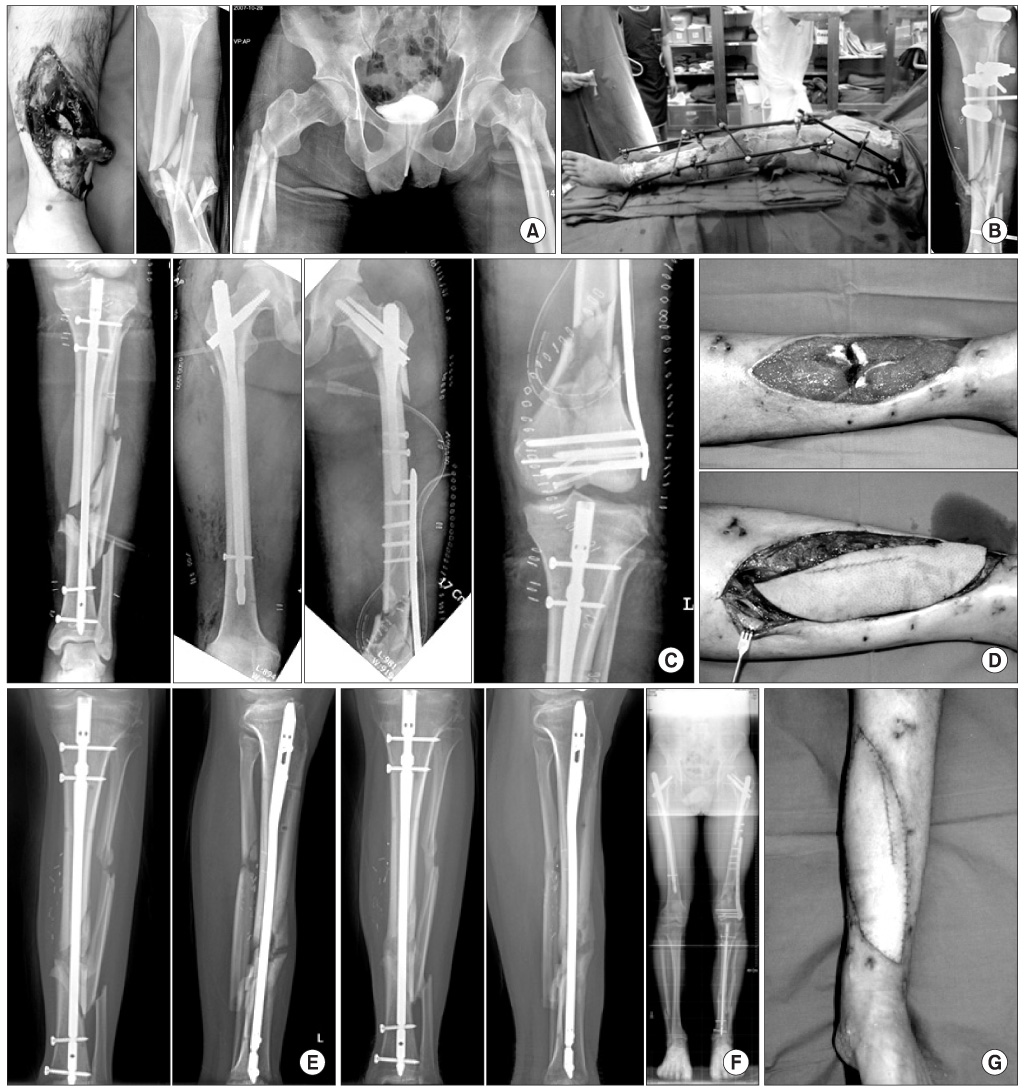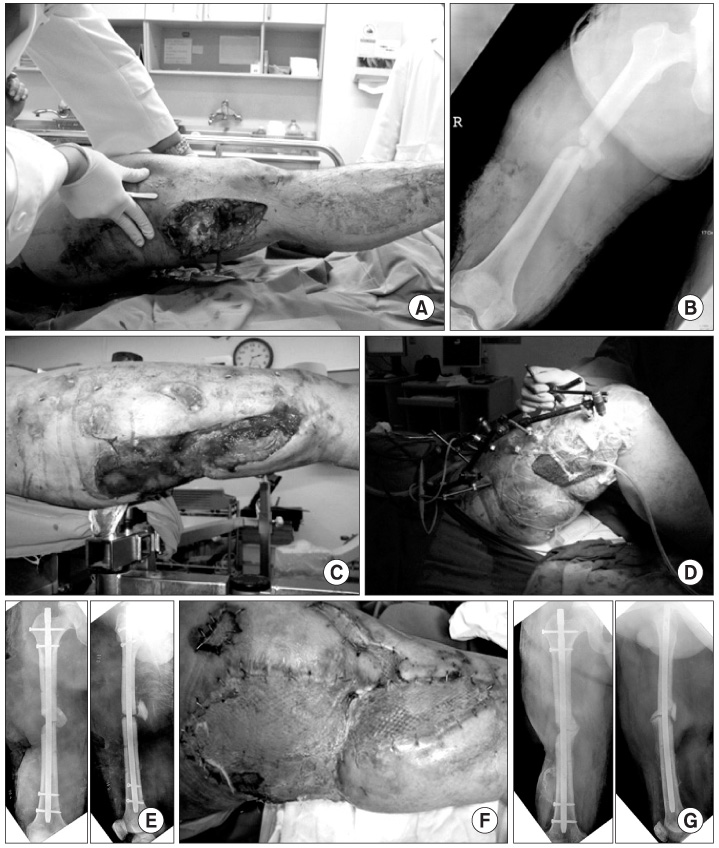J Korean Orthop Assoc.
2012 Apr;47(2):125-132. 10.4055/jkoa.2012.47.2.125.
Delayed Soft Tissue Coverage after Negative Pressure Wound Therapy in Open Fractures of Lower Extremities
- Affiliations
-
- 1Department of Orthopedic Surgery, Guri Hospital, Hanyang University College of Medicine, Guri, Korea. kcpark@hanyang.ac.kr
- 2Department of Plastic Surgery, Guri Hospital, Hanyang University College of Medicine, Guri, Korea.
- KMID: 2185388
- DOI: http://doi.org/10.4055/jkoa.2012.47.2.125
Abstract
- PURPOSE
To evaluate the delayed soft tissue coverage after previous negative wound therapy in treating wounds associated with open lower extremity fracture.
MATERIALS AND METHODS
Between June 2007 and February 2011, delayed soft tissue coverage of open lower extremity fractures after previous use of a negative pressure vacuum device, were performed in 15 consecutive patients. Patients included 13 male and 2 female, and their mean age was 39.0 (7-65) years old. Information on the time from injury to definitive wound coverage, type of coverage, functional result, bone union, and complications such as infection were collected.
RESULTS
The vacuum-assisted closure devices was applied for an average of 29.3 (9-50) days, and the mean time from injury to definitive wound was 36.1 (21-60) days. Skin graft coverage was performed in 5 cases, free flap in 8 cases, and local flap in 3 cases. The mean time to radiographic union was 5.2 (3-8) months and delayed union occurred in 2 cases.
CONCLUSION
Delayed soft tissue coverage after previous negative wound therapy was considered an alternative treatment method in open lower extremity fractures associated with severe concomitant injury.
MeSH Terms
Figure
Reference
-
1. Yazar S, Lin CH, Wei FC. One-stage reconstruction of composite bone and soft-tissue defects in traumatic lower extremities. Plast Reconstr Surg. 2004. 114:1457–1466.
Article2. Godina M. Early microsurgical reconstruction of complex trauma of the extremities. Plast Reconstr Surg. 1986. 78:285–292.
Article3. Steiert AE, Gohritz A, Schreiber TC, Krettek C, Vogt PM. Delayed flap coverage of open extremity fractures after previous vacuum-assisted closure (VAC) therapy - worse or worth? J Plast Reconstr Aesthet Surg. 2009. 62:675–683.
Article4. Gustilo RB, Mendoza RM, Williams DN. Problems in the management of type III (severe) open fractures: a new classification of type III open fractures. J Trauma. 1984. 24:742–746.5. Klemm KW, Börner M. Interlocking nailing of complex fractures of the femur and tibia. Clin Orthop Relat Res. 1986. 212:89–100.
Article6. Yaremchuk MJ, Brumback RJ, Manson PN, Burgess AR, Poka A, Weiland AJ. Acute and definitive management of traumatic osteocutaneous defects of the lower extremity. Plast Reconstr Surg. 1987. 80:1–14.
Article7. Ninković M, Schoeller T, Benedetto KP, Anderl H. Emergency free flap cover in complex injuries of the lower extremities. Scand J Plast Reconstr Surg Hand Surg. 1996. 30:37–47.8. Hildebrand F, Giannoudis P, Kretteck C, Pape HC. Damage control: extremities. Injury. 2004. 35:678–689.
Article9. Roberts CS, Pape HC, Jones AL, Malkani AL, Rodriguez JL, Giannoudis PV. Damage control orthopaedics: evolving concepts in the treatment of patients who have sustained orthopaedic trauma. Instr Course Lect. 2005. 54:447–462.10. Cierny G 3rd, Byrd HS, Jones RE. Primary versus delayed soft tissue coverage for severe open tibial fractures. A comparison of results. Clin Orthop Relat Res. 1983. 178:54–63.11. DeFranzo AJ, Argenta LC, Marks MW, et al. The use of vacuum-assisted closure therapy for the treatment of lower-extremity wounds with exposed bone. Plast Reconstr Surg. 2001. 108:1184–1191.
Article12. Kanakaris NK, Thanasas C, Keramaris N, Kontakis G, Granick MS, Giannoudis PV. The efficacy of negative pressure wound therapy in the management of lower extremity trauma: review of clinical evidence. Injury. 2007. 38:Suppl 5. S9–S18.
Article13. Joseph E, Hamori CA, Bergman S, Roaf E, Swann NF, Anastasi GW. A prospective randomized trial of vacuum-assisted closure versus standard therapy of chronic nonhealing wounds. Wounds. 2000. 12:60–67.14. Hertel R, Lambert SM, Müller S, Ballmer FT, Ganz R. On the timing of soft-tissue reconstruction for open fractures of the lower leg. Arch Orthop Trauma Surg. 1999. 119:7–12.
Article15. Kesemenli CC, Kapukaya A, Subaşi M, Arslan H, Necmioğlu S, Kayikçi C. Early prophylactic autogenous bone grafting in type III open tibial fractures. Acta Orthop Belg. 2004. 70:327–331.
- Full Text Links
- Actions
-
Cited
- CITED
-
- Close
- Share
- Similar articles
-
- Conventional versus Instillation Negative-Pressure Wound Therapy for Severe Soft Tissue Injury in Open Pelvic Fractures: A Retrospective Review
- Soft Tissue Reconstruction for Open Tibia Fractures
- Reconstruction of a Traumatic Soft Tissue Defect
- Treatment of Type IIIb Open Tibial Fractures
- Salvage of Both Lower Limbs with Multiple Crushing Injuries in an Octogenarian



